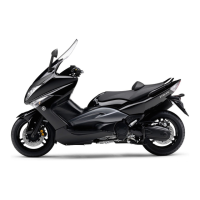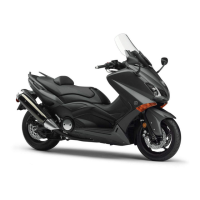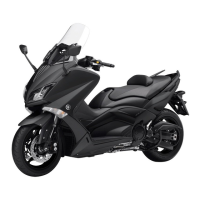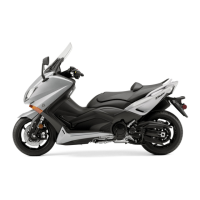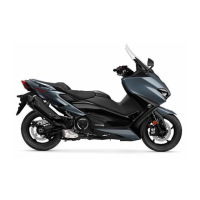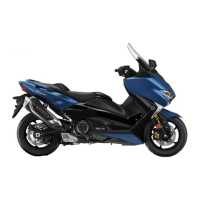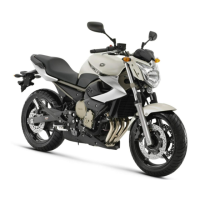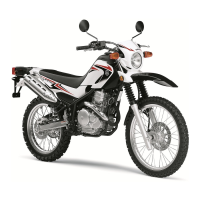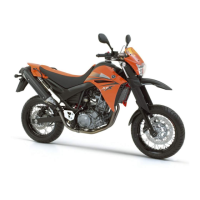Do you have a question about the Yamaha XP500 and is the answer not in the manual?
Details for identifying the scooter model and VIN.
Overview of key features including FI and ABS systems.
Crucial guidelines for preparation, parts, and handling during service.
List of specialized tools required for maintenance and assembly.
Key physical dimensions, weight, and load capacities of the scooter.
Detailed technical data for engine components, fluids, and performance.
Specifications for frame, wheels, tires, brakes, and suspension systems.
Data for electrical system components, battery, fuses, and lighting.
Specifies torque values for standard fasteners and general tightening practices.
Identifies lubrication points and recommended lubricants for engine and chassis.
Schedule of recommended maintenance tasks based on mileage and time intervals.
Steps for removing and installing body panels like cowling and leg shields.
Procedures for removing, installing, and checking the fuel tank and pump.
Checks and adjustments for valve clearance, throttle bodies, and engine components.
Checks and adjustments for brakes, steering, front fork, tires, and wheels.
Checks and charging procedures for the battery and fuses.
Removal, installation, checking, and balancing of the front wheel and brake disc.
Procedures for removing, installing, and checking the rear wheel and brake disc.
Detailed instructions for replacing brake pads and servicing brake calipers and master cylinders.
Steps for removing, checking, and installing the handlebar assembly.
Procedures for removing, disassembling, checking, and installing the front fork legs.
Steps for removing, checking, adjusting, and installing the steering head components.
Handling, disposal, removal, checking, and installation of the rear shock absorber assembly.
Overview of ABS components, circuit diagram, and troubleshooting.
Procedures for removing the engine, including muffler and associated leads.
Instructions for removing, checking, and installing camshafts and related parts.
Steps for removing, checking, and installing the cylinder head and gasket.
Procedures for removing, checking, and installing valves, springs, and related components.
Steps for removing, checking, and installing cylinders, pistons, and rings.
Procedures for removing, checking, and installing the starter clutch and A.C. magneto rotor.
Instructions for checking and assembling the engine oil pump and its components.
Procedures for removing, disassembling, checking, and assembling the clutch.
Steps for removing, disassembling, checking, and assembling the V-belt and sheave components.
Procedures for removing, disassembling, checking, and installing crankcase and crankshaft components.
Procedures for removing, checking, and installing the radiator and oil cooler.
Instructions for checking and installing the thermostat and its housing.
Procedures for removing, disassembling, checking, assembling, and installing the water pump.
Overview of the FI system, wiring diagram, ECU diagnostics, and fail-safe actions.
Guide to diagnosing and resolving fuel injection system malfunctions based on fault codes.
Steps for entering and using the diagnostic mode to check sensor and actuator operation.
Lists fault codes, symptoms, probable causes, and diagnostic codes for FI system issues.
Diagram showing the location of major electrical system components on the scooter.
Procedure for testing switch continuity using a pocket tester and checking wiring.
Guidelines for checking switches for damage, wear, proper connection, and continuity.
Steps for checking bulb and socket condition, continuity, and types used.
Troubleshooting steps for ignition system failures, including spark plugs and coils.
Circuit diagrams and troubleshooting for the electric starting system components and operation.
Procedures for removing, disassembling, checking, and assembling the starter motor.
Circuit diagram and troubleshooting steps for charging system issues like battery not charging.
Troubleshooting for lighting system failures, including bulbs, sockets, and circuits.
Troubleshooting steps for turn signals, hazard lights, horn, and brake lights.
Troubleshooting for cooling system issues, including fan motor and coolant sensor.
General information, system diagrams, key registration, and troubleshooting for the immobilizer system.
Lists potential causes and checks for engine starting problems.
Identifies causes for engine idling issues, performance problems, and clutch malfunctions.
Lists potential causes for engine overheating and overcooling issues.
Common causes for suboptimal braking performance.
Identifies causes for front fork malfunctions, including oil leaks and bent components.
Factors affecting scooter handling, such as handlebar, steering head, and suspension.
Common issues and causes for lighting and signaling system failures.
Details for identifying the scooter model and VIN.
Overview of key features including FI and ABS systems.
Crucial guidelines for preparation, parts, and handling during service.
List of specialized tools required for maintenance and assembly.
Key physical dimensions, weight, and load capacities of the scooter.
Detailed technical data for engine components, fluids, and performance.
Specifications for frame, wheels, tires, brakes, and suspension systems.
Data for electrical system components, battery, fuses, and lighting.
Specifies torque values for standard fasteners and general tightening practices.
Identifies lubrication points and recommended lubricants for engine and chassis.
Schedule of recommended maintenance tasks based on mileage and time intervals.
Steps for removing and installing body panels like cowling and leg shields.
Procedures for removing, installing, and checking the fuel tank and pump.
Checks and adjustments for valve clearance, throttle bodies, and engine components.
Checks and adjustments for brakes, steering, front fork, tires, and wheels.
Checks and charging procedures for the battery and fuses.
Removal, installation, checking, and balancing of the front wheel and brake disc.
Procedures for removing, installing, and checking the rear wheel and brake disc.
Detailed instructions for replacing brake pads and servicing brake calipers and master cylinders.
Steps for removing, checking, and installing the handlebar assembly.
Procedures for removing, disassembling, checking, and installing the front fork legs.
Steps for removing, checking, adjusting, and installing the steering head components.
Handling, disposal, removal, checking, and installation of the rear shock absorber assembly.
Overview of ABS components, circuit diagram, and troubleshooting.
Procedures for removing the engine, including muffler and associated leads.
Instructions for removing, checking, and installing camshafts and related parts.
Steps for removing, checking, and installing the cylinder head and gasket.
Procedures for removing, checking, and installing valves, springs, and related components.
Steps for removing, checking, and installing cylinders, pistons, and rings.
Procedures for removing, checking, and installing the starter clutch and A.C. magneto rotor.
Instructions for checking and assembling the engine oil pump and its components.
Procedures for removing, disassembling, checking, and assembling the clutch.
Steps for removing, disassembling, checking, and assembling the V-belt and sheave components.
Procedures for removing, disassembling, checking, and installing crankcase and crankshaft components.
Procedures for removing, checking, and installing the radiator and oil cooler.
Instructions for checking and installing the thermostat and its housing.
Procedures for removing, disassembling, checking, assembling, and installing the water pump.
Overview of the FI system, wiring diagram, ECU diagnostics, and fail-safe actions.
Guide to diagnosing and resolving fuel injection system malfunctions based on fault codes.
Steps for entering and using the diagnostic mode to check sensor and actuator operation.
Lists fault codes, symptoms, probable causes, and diagnostic codes for FI system issues.
Diagram showing the location of major electrical system components on the scooter.
Procedure for testing switch continuity using a pocket tester and checking wiring.
Guidelines for checking switches for damage, wear, proper connection, and continuity.
Steps for checking bulb and socket condition, continuity, and types used.
Troubleshooting steps for ignition system failures, including spark plugs and coils.
Circuit diagrams and troubleshooting for the electric starting system components and operation.
Procedures for removing, disassembling, checking, and assembling the starter motor.
Circuit diagram and troubleshooting steps for charging system issues like battery not charging.
Troubleshooting for lighting system failures, including bulbs, sockets, and circuits.
Troubleshooting steps for turn signals, hazard lights, horn, and brake lights.
Troubleshooting for cooling system issues, including fan motor and coolant sensor.
General information, system diagrams, key registration, and troubleshooting for the immobilizer system.
Lists potential causes and checks for engine starting problems.
Identifies causes for engine idling issues, performance problems, and clutch malfunctions.
Lists potential causes for engine overheating and overcooling issues.
Common causes for suboptimal braking performance.
Identifies causes for front fork malfunctions, including oil leaks and bent components.
Factors affecting scooter handling, such as handlebar, steering head, and suspension.
Common issues and causes for lighting and signaling system failures.
| Manufacturer | Yamaha |
|---|---|
| Model | XP500 |
| Displacement | 499cc |
| Fuel System | Fuel Injection |
| Ignition | TCI |
| Starter System | Electric |
| Front Tire | 120/70-15 |
| Rear Tire | 160/60-15 |
| Length | 2, 195 mm |
| Transmission | Automatic |
| Front Suspension | Telescopic forks |
| Rear Suspension | Swingarm |
| Fuel Capacity | 15.0 L |
